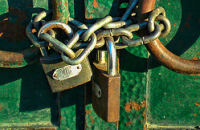Just as the Tin-man, Scarecrow, Dorothy and the Lion turned to the Wizard of Oz for solutions to their problems (a missing heart, brain, courage and a home, respectively), retailers are embracing mobile POS as a customer-centric solution that helps with line-busting, returns management, stock allocation and stock identification. Mobile POS can also assist retailers to collect customer information for loyalty programs and safely transfer it wirelessly to a secure ERP system.
Is mobility the solution you’re looking for? How do retailers create a mobile point of sale experience? Let’s draw back the curtain on this Wonderful Wizard of POS and find out how mobile point of sale and other mobile solutions tap into secure ERP systems to deliver customer satisfaction.
If Store Inventory Had a Brain?
Without mobility, the average stock check experience is not very smart. Imagine this: a customer approaches a sales associate and asks if they have a skirt in a size 6. While the clerk leaves the customer to check the back room for their requested items, any number of things can happen. The customer could lose interest and decide not to buy that skirt at all. At minimum, the clerk has to check the warehouse and other stores for their inventory, all while the customer is left feeling increasingly dissatisfied.
However, when a retailer is equipped with mobile devices that integrate smoothly into a ERP system, the customer experience changes dramatically. Instead of disappearing to the back room, the clerk’s mobile device instantly recognizes the item and locates the nearby inventory. The clerk can then tell the customer whether that size 6 skirt is down the street, or in the warehouse or at another store. If the requested item is available, the clerk can offer to have it shipped directly to their house.
As a retailer, this scenario puts customer service first and eliminates obstacles between the customer and point of purchase. The clerk remains present throughout the entire process and at the scan of a barcode is informed of available inventory, creating a seamless customer experience. If the mobile device is equipped with a mobile POS application, the clerk could even process the customer’s order on the spot.
Get the Lion’s Share of Line Busting
From the dawn of retail, line busting has been a top priority for retailers. The lion from the Wizard of Oz would agree that it takes a lot of c-c-courage and leadership to implement a solution aimed at reducing lines.
Many retailers start exploring mobile solutions by implementing a stationary point of sale system that can interface with mobile solutions easily. For example, if your store was using an IBM SurePOS™ check out system, a clerk could scan a customer’s information while he or she was in the store. Then when the customer went to cash out, their name and relevant information would already integrated within an IBM SurePOS™ system and stored in the database making for faster transactions and, ultimately, reduced costs and shorter lines.
Although most retailers could benefit from implementing at least one mobile solution, home and garden stores particularly stand to gain much from taking their point of sale systems mobile and virtually eliminating lines all together. Imagine if a customer could purchase 4 bags of mulch and a variety of plants without having to walk through a check out line. A clerk would simply approach the customer, scan the appropriate barcodes, and then be free to help load up the customer’s car.
Give Customer Loyalty a Hand (and a Heart)
Today, customer loyalty programs are often tacked on to the end of a long check out process. Imagine that instead your organization could take customers’ information whilethey were walking through the store. The store representative would scan a customer’s driver’s license and store only the information that is pertinent for the loyalty program. The information would be correct, it would be spelled properly and also contain the proper address. The customer wouldn’t have to fill out any paperwork or wait in line and the data on file won’t be spelled 5 different ways. Since the mobile device wirelessly transfers data to your secure ERP solution database, the customer’s identity is recognized throughout the entire retail chain. If your customer loves your store, they’ll love you even more for caring about their customer loyalty.
Send Customers Home Happy (After Returning Inventory)
When Dorothy attempts to leave Oz, a place that doesn’t seem to understand her or her needs, she clicks her heels and says, “There’s no place like home. There’s no place like home.” While your customers may not have walloped the Wicked Witch of the East with a house, they may be wishing for the sweet release of home after an excruciating half an hour trying to return an item.
One of the most stressful operational problems organizations face involves the question of handling customer returns in a way that actually increases customer satisfaction. Today, most customers wait in a check-out line for 30 minutes to exchange unwanted items. By the time the customer has moved through the line and had a return processed, they are so frustrated that when asked if they’d like to shop or get their money back, they’ll often choose the latter and head on home.
At Magstar, we look at mobile POS from the perspective of the customer. We ask, “How can we use mobile POS to streamline return management and send customers home happy?”
We believe that if retailers performed return management via a mobile device as soon as a customer walked into the store it would improve the return experience. The clerk would scan the barcode of the return, hand the customer a bar-coded receipt and say, “Okay, go shop.” Then, when the customer found what they need, they’d check out as easily as clicking their heels. And they’d head home happy.
 Mobility, whether it be at the point of sale (POS) or at other points within the customer relationship management process, is as hot in the retail industry today as the Wizard was in the Land of Oz. In January 2011,
Mobility, whether it be at the point of sale (POS) or at other points within the customer relationship management process, is as hot in the retail industry today as the Wizard was in the Land of Oz. In January 2011, 
